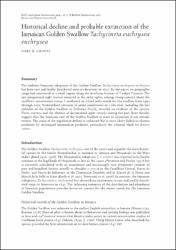| Author | Graves, Gary R. | |
| Accessioned date | 2023-09-25T00:13:49Z | |
| Available date | 2023-09-25T00:13:49Z | |
| Year | 2013 | |
| Citation | Graves, G. R. (2013). Historical decline and probable extinction of the Jamaican Golden Swallow Tachycineta euchrysea euchrysea. Bird Conservation International, 24(2), 239-251. Recuperado de: | es |
| URI | https://bvearmb.do/handle/123456789/3353 | |
| Abstract | The endemic Jamaican subspecies of the Golden Swallow Tachycineta euchrysea euchrysea has been rare and locally distributed since its discovery in 1847. By the 1950s, its geographic range had contracted to a small region along the northern frontier of Cockpit Country. The last unequivocal sight records occurred in the early 1980s, raising strong concern about the swallow’s conservation status. I conducted an island-wide search for the swallow from 1994 through 2012. Standardised censuses of aerial insectivores at 1,281 sites, including the last redoubts of the Golden Swallow in Trelawny Parish, revealed no evidence of the species. These surveys and the absence of documented sight records during the past three decades suggest that the Jamaican race of the Golden Swallow is close to extinction if not already extinct. The cause of the population decline is unknown but is most likely linked to chronic predation by introduced mammalian predators, particularly the arboreal black rat Rattus rattus. | es |
| Language | English | es |
| Published | Bird Conservation International, 24(2), 239-251 | es |
| Rights | © Bird Conservation International. | es |
| Subject | Biodiversidad - República Dominicana | es |
| Subject | Aves ─ República Dominicana | es |
| Subject | Hábitats y especies | es |
| Subject | Especies amenazadas | es |
| Title | Historical decline and probable extinction of the Jamaican Golden Swallow Tachycineta euchrysea euchrysea | es |
| dc.identifier.doi | https://doi.org/10.1017/S095927091300035X | |
| Material type | Article | es |
| Type of content | Scientific research | es |
| Access | Open | es |
| Audience | Technicians, professionals and scientists | es |


